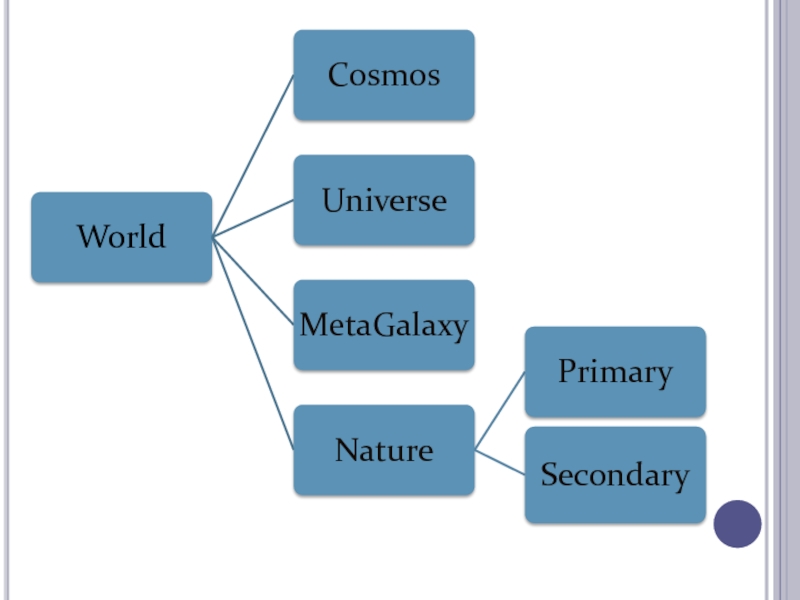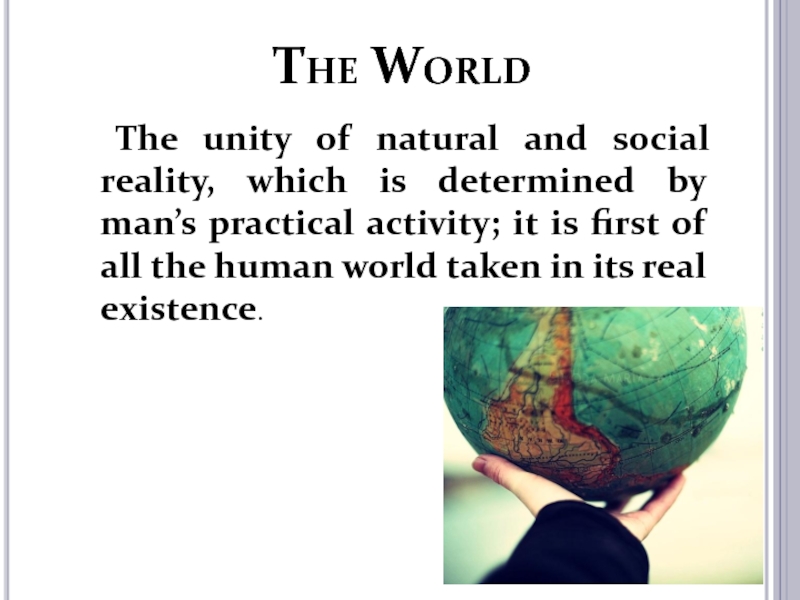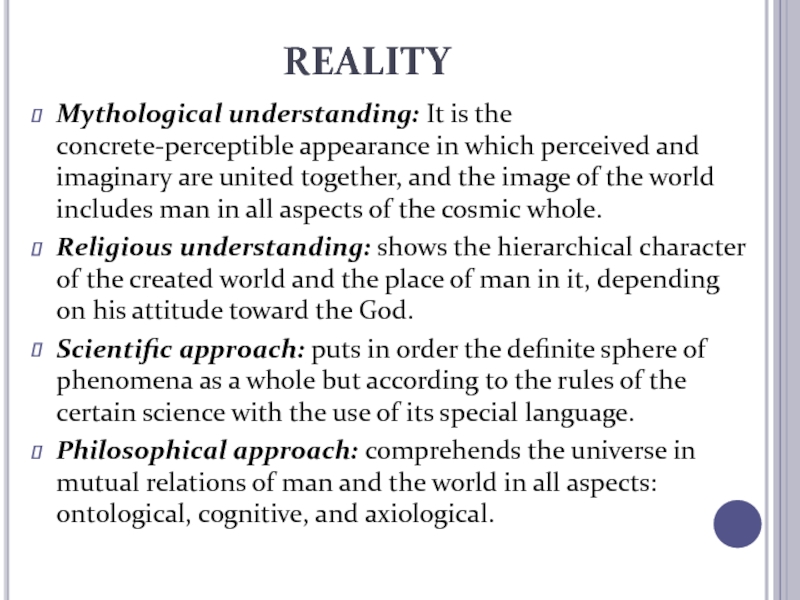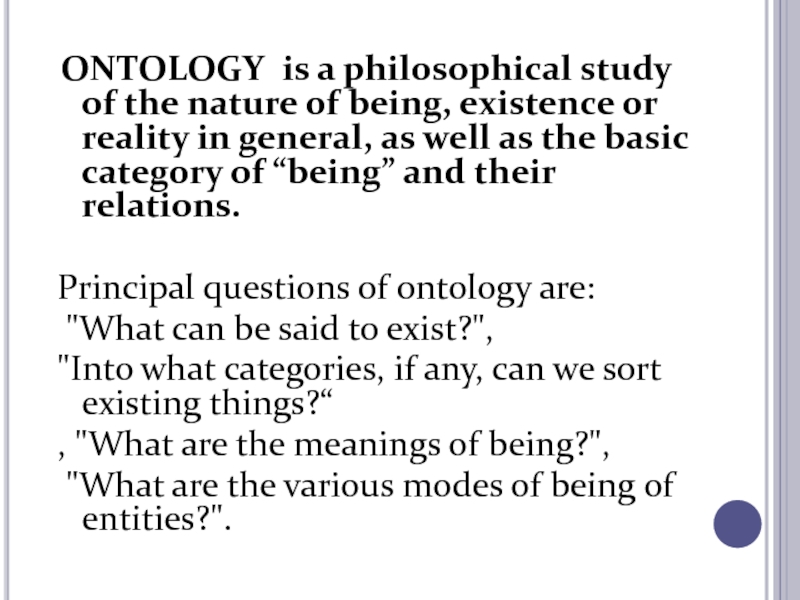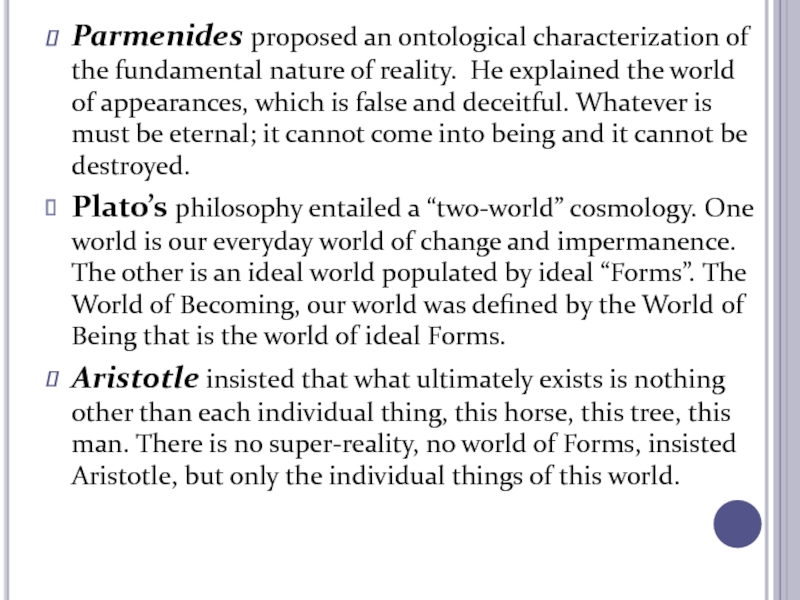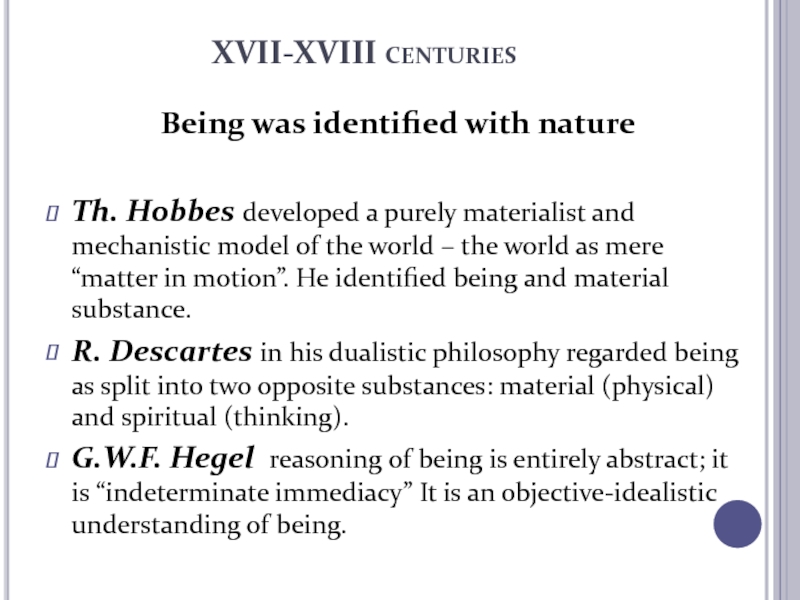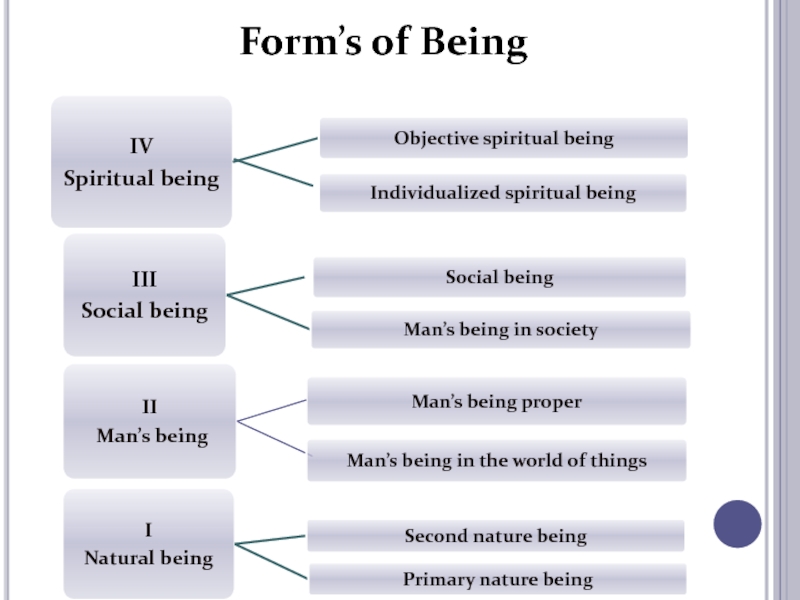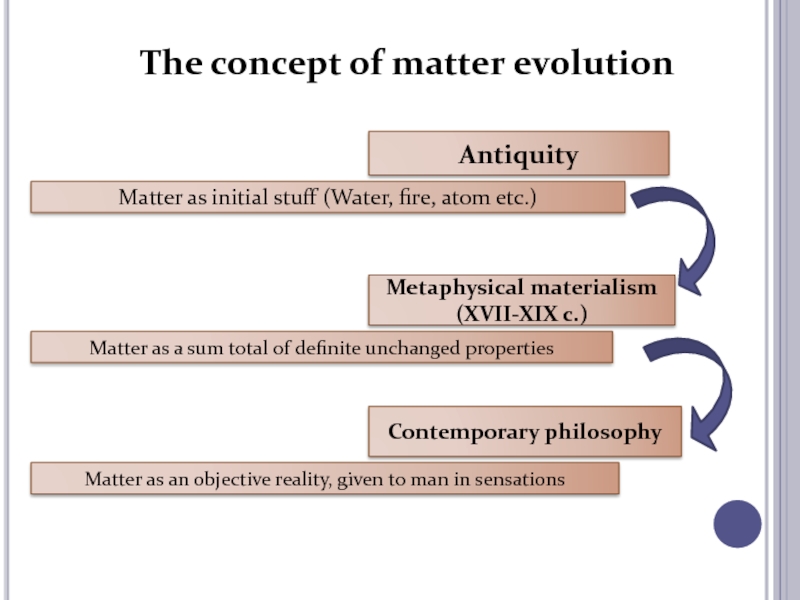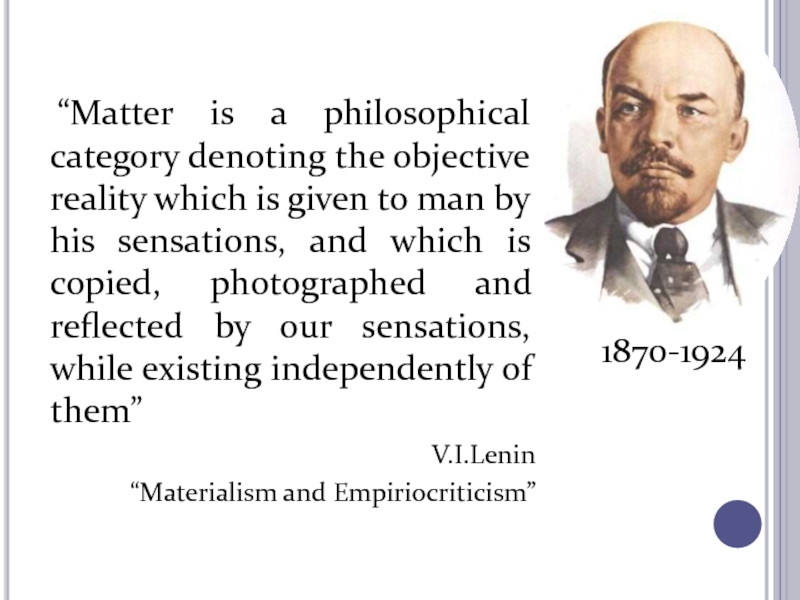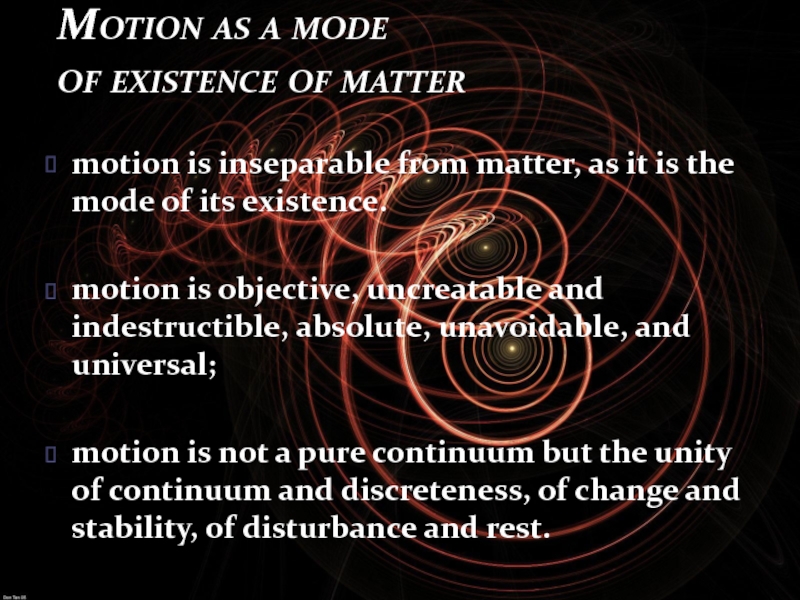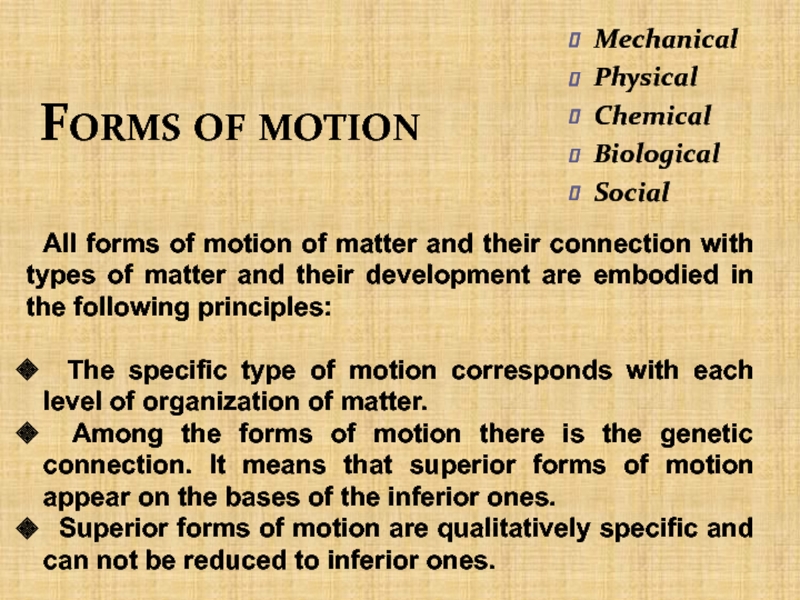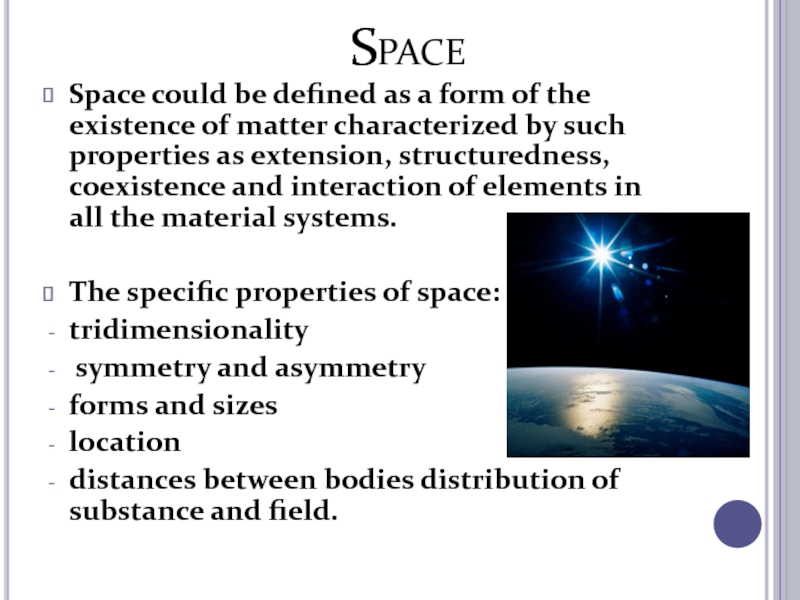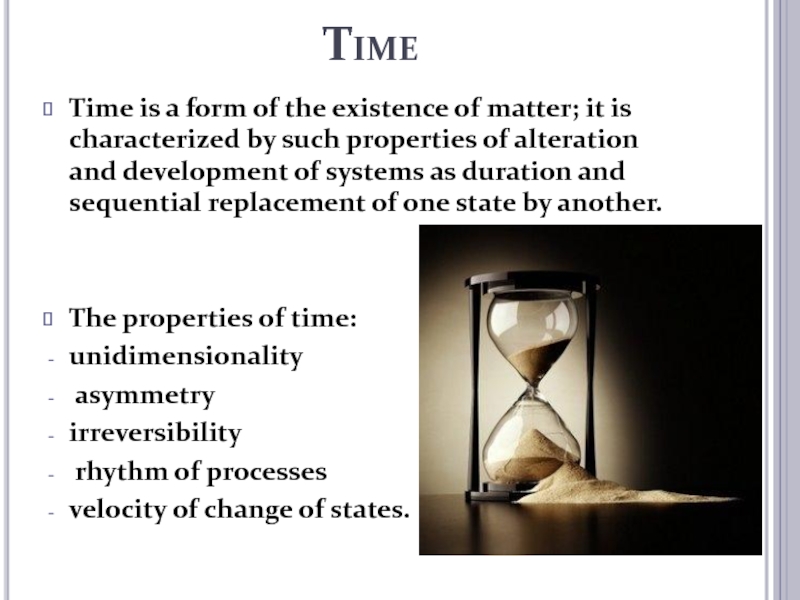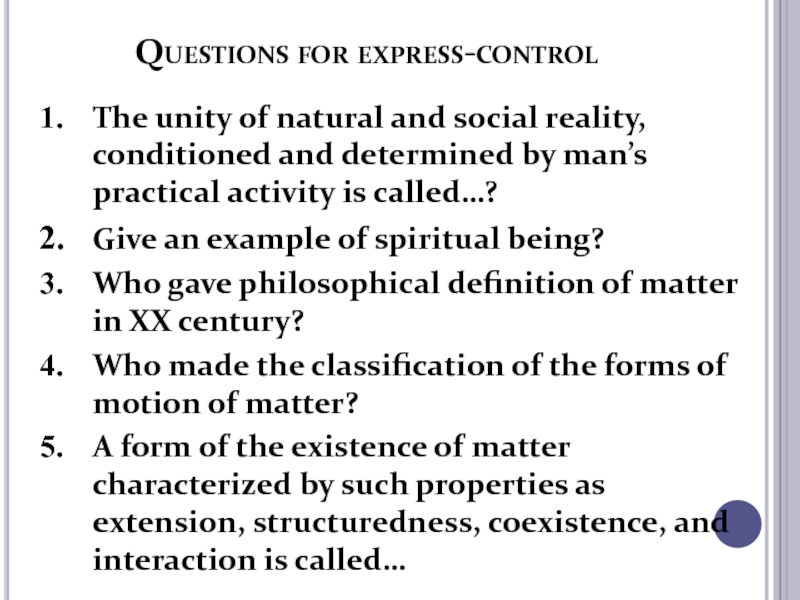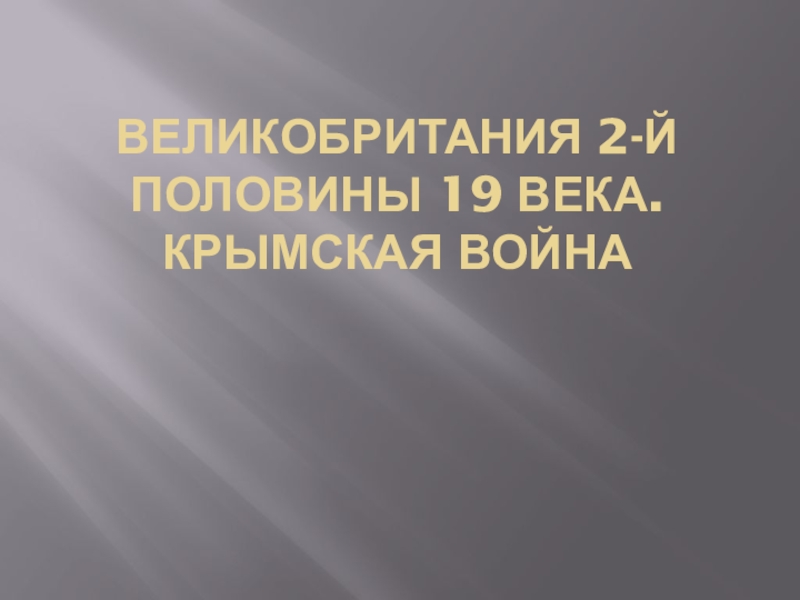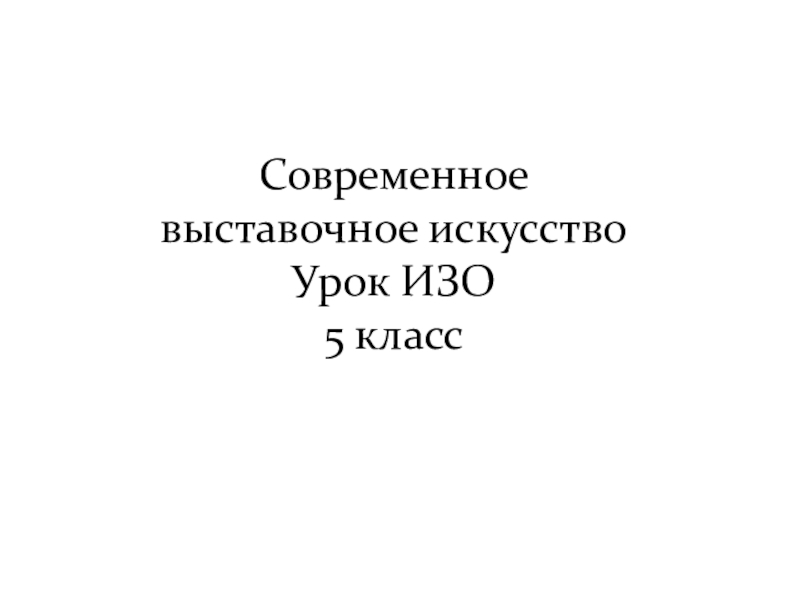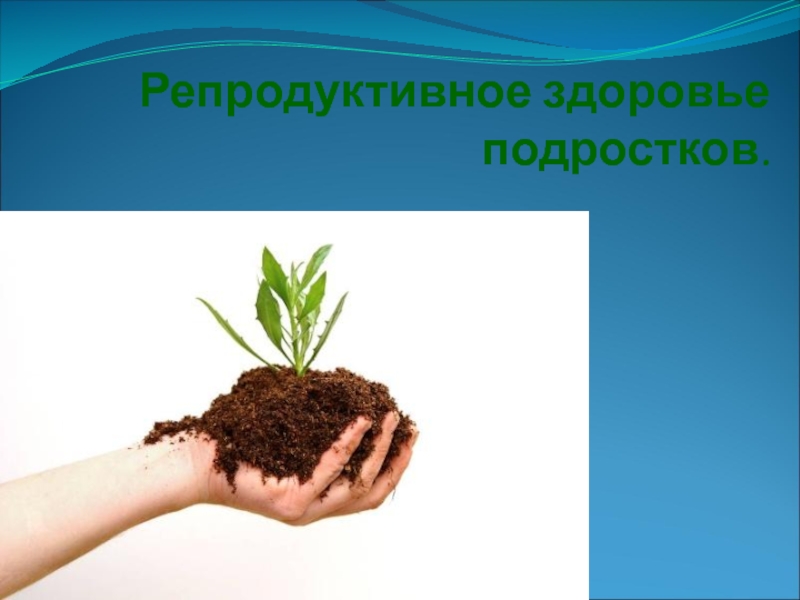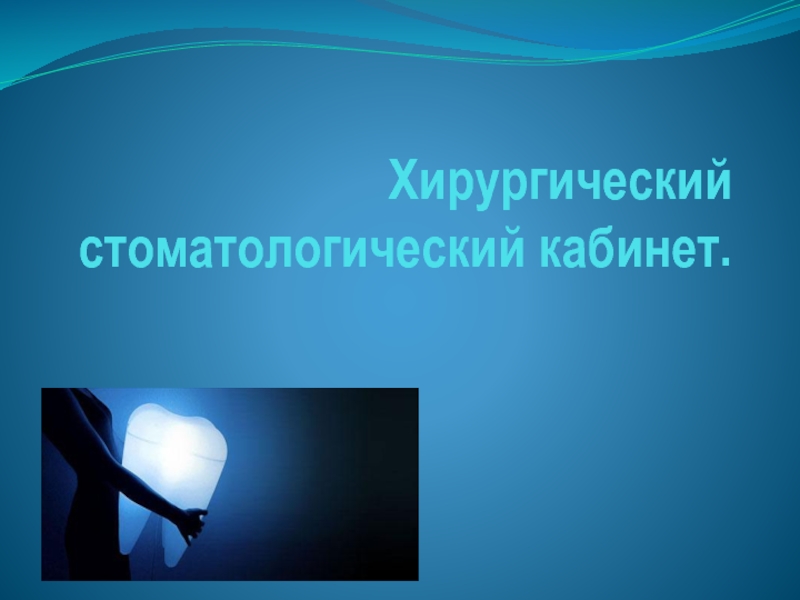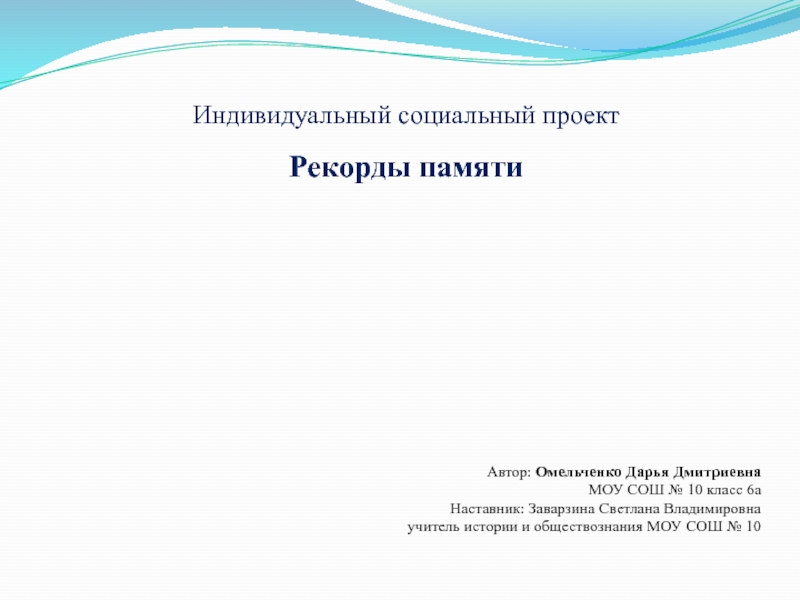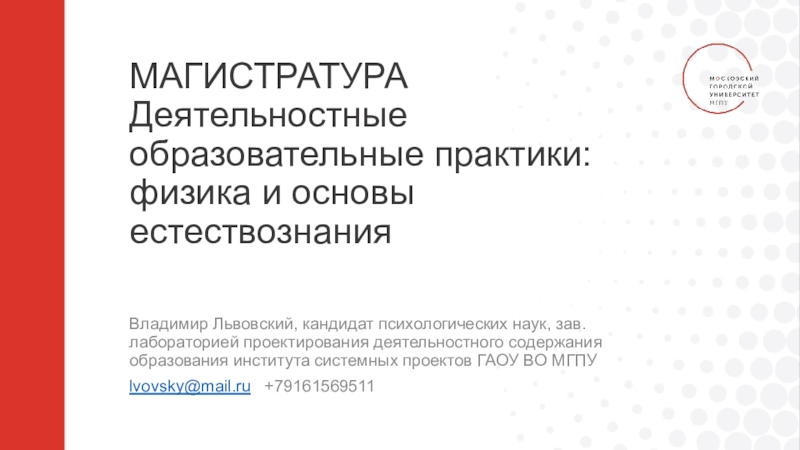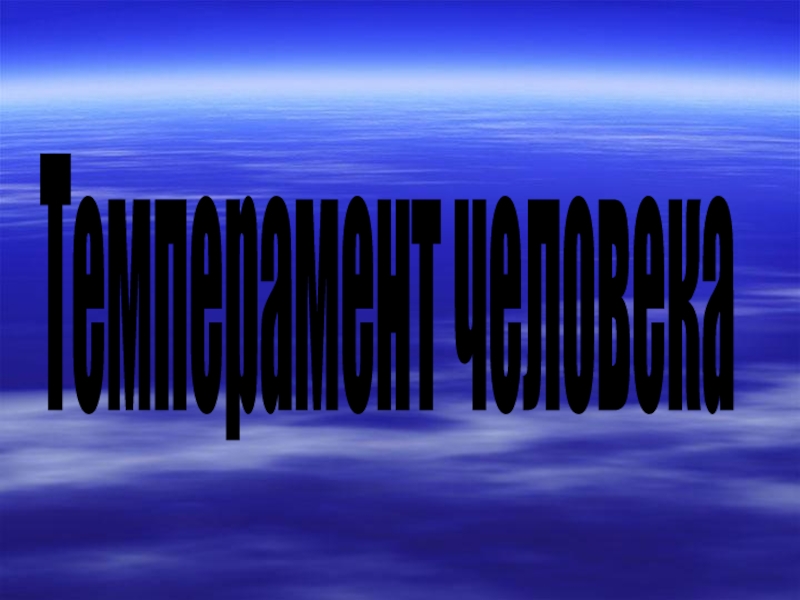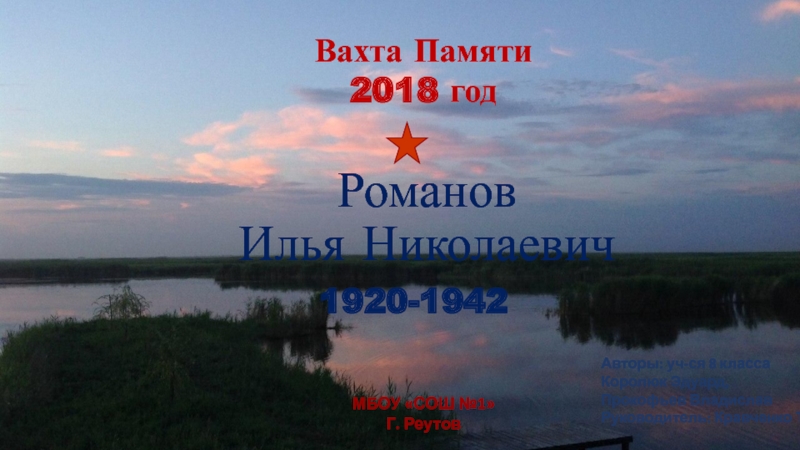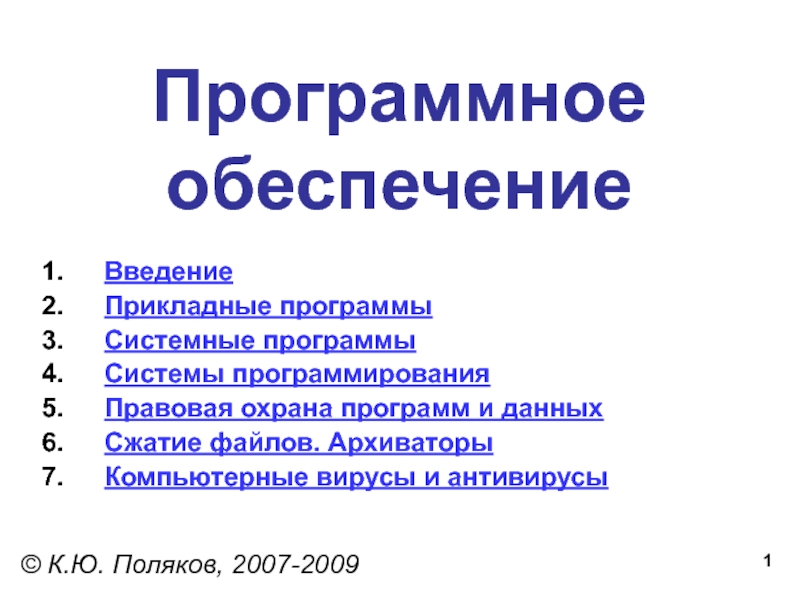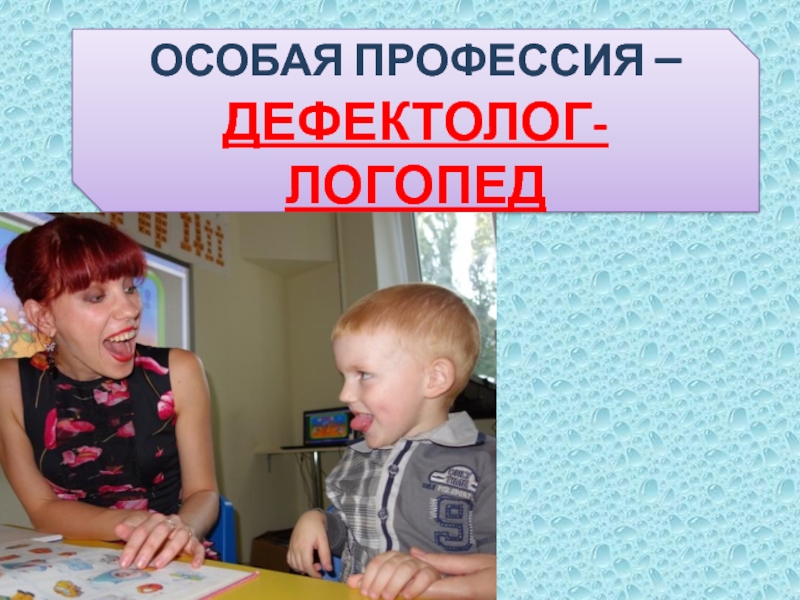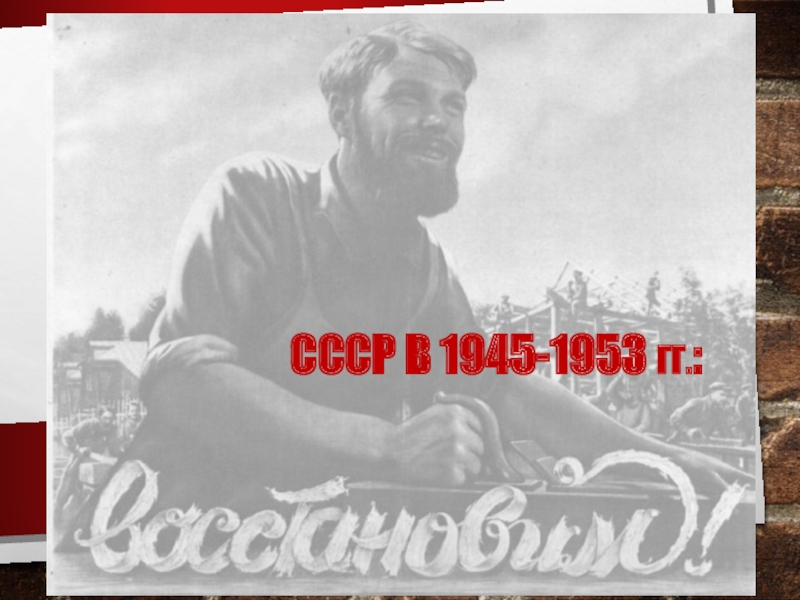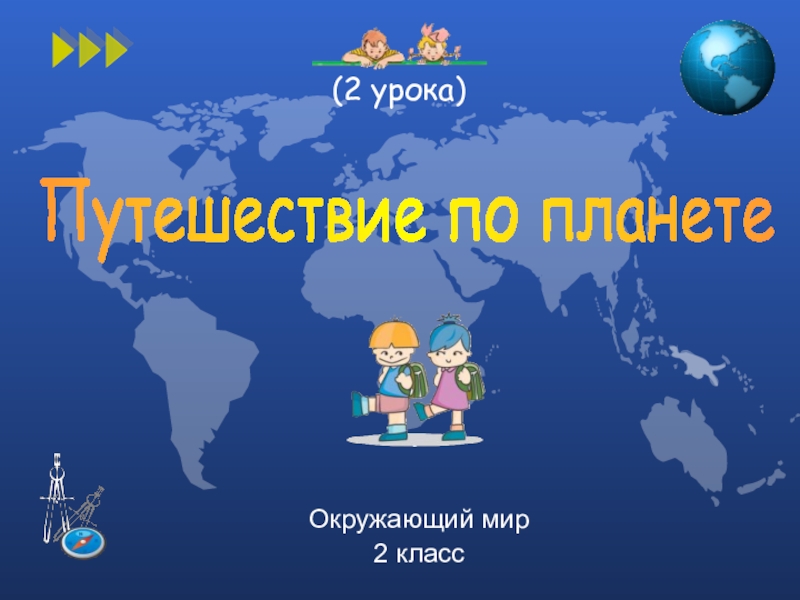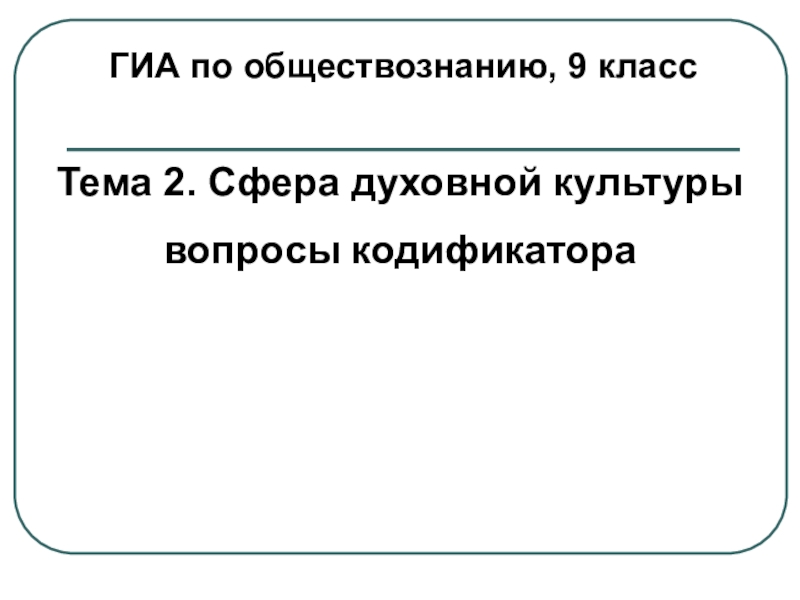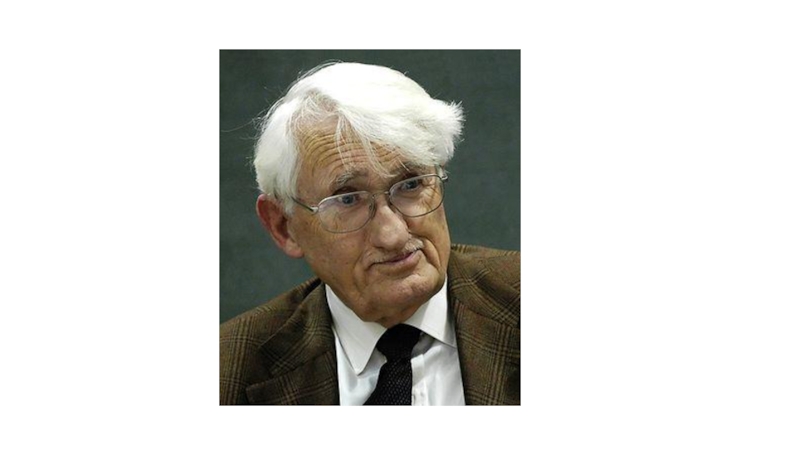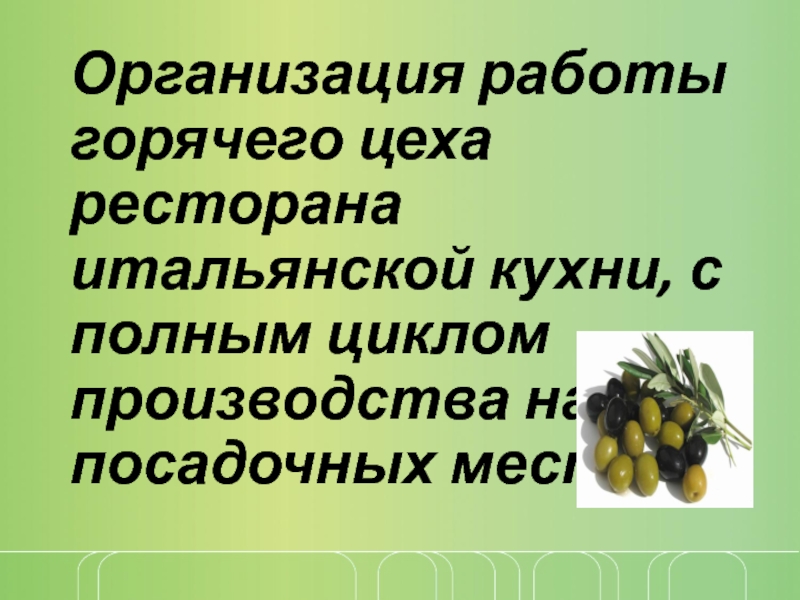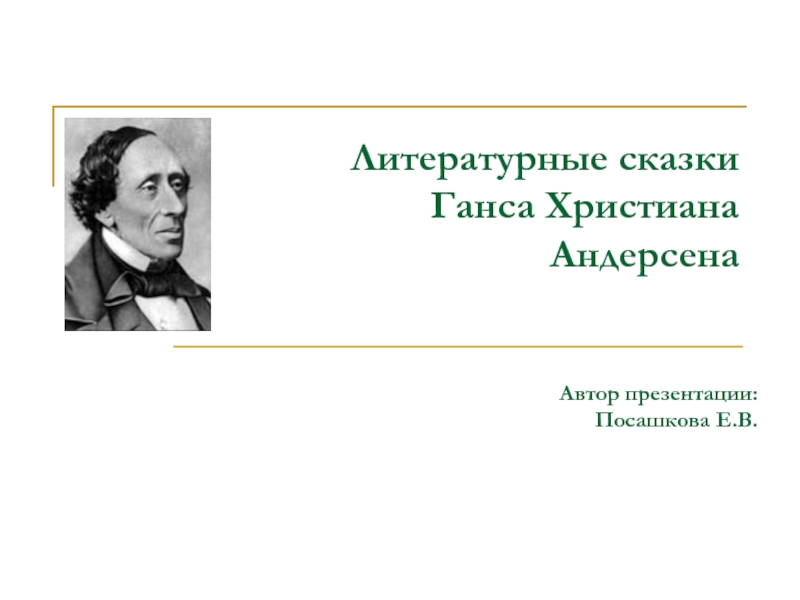Разделы презентаций
- Разное
- Английский язык
- Астрономия
- Алгебра
- Биология
- География
- Геометрия
- Детские презентации
- Информатика
- История
- Литература
- Математика
- Медицина
- Менеджмент
- Музыка
- МХК
- Немецкий язык
- ОБЖ
- Обществознание
- Окружающий мир
- Педагогика
- Русский язык
- Технология
- Физика
- Философия
- Химия
- Шаблоны, картинки для презентаций
- Экология
- Экономика
- Юриспруденция
PHILOSOPHICAL THEORY OF BEING
Содержание
- 1. PHILOSOPHICAL THEORY OF BEING
- 2. PlanThe conception of the world and being
- 3. LiteratureBasic:Alexander Spirkin. Dialectical Materialism / Alexander Spirkin
- 4. Слайд 4
- 5. The WorldThe unity of natural and social
- 6. REALITYMythological understanding: It is the concrete-perceptible appearance
- 7. ONTOLOGY is a philosophical study of
- 8. Parmenides proposed an ontological characterization of the
- 9. XVII-XVIII centuriesBeing was identified with natureTh. Hobbes
- 10. Form’s of Being
- 11. AntiquityMatter as an objective reality, given to
- 12. “Matter is a philosophical category denoting the
- 13. Levels of organization of matter:Inorganic nature (elementary
- 14. Motion as a mode of existence
- 15. Forms of motionMechanicalPhysicalChemicalBiologicalSocialAll forms of motion of
- 16. Space Space could be defined as a
- 17. TimeTime is a form of the existence
- 18. Space and time are absolute.
- 19. Social space and time Social space is
- 20. Questions for express-controlThe unity of natural and
- 21. Скачать презентанцию
PlanThe conception of the world and being in philosophy.The general concept of Matter. Attributes of Matter: Motion, Space and Time.Social Space and Social Time as forms of man’s being in culture.
Слайды и текст этой презентации
Слайд 2Plan
The conception of the world and being in philosophy.
The general
concept of Matter. Attributes of Matter: Motion, Space and Time.
Space and Social Time as forms of man’s being in culture.Слайд 3Literature
Basic:
Alexander Spirkin. Dialectical Materialism / Alexander Spirkin : [transl. by
Robert Daglish]. — M. : Progress Publishers, 1983. − 342
p.John Heil. From an Ontological Point of View / John Heil. — New York : Oxford University Press, 2003. — 267 p.
Jan Westerhoff. Ontological Categories: Their nature and Significance / Jan Westerhoff. — New York : Oxford University Press, 2005. − 261 p.
Supplementary:
Essays in Ontology / [Edwin B. Allaire and others]. − Iowa City : University of Iowa, 1963. − 215 p.
Handbook of Metaphysics and Ontology / Hans Burkhardt, Barry Smith. − Philadelphia : Philosophia Verlag, 1991. − 1005 p.
Primary sources:
Aristotle. Metaphysics / Aristotle : [transl. by W. D. Ross]. – Nashotah, Wisconsin : The Classical Library, 2001. — P. 55−71.
Gebhard Geiger. Evolutionary Instability: Logical and Material Aspects of a Unified Theory of Biosocial Evolution / Gebhard Geiger. — New York : Springer-Verlag, 1990. — 167 p.
Martin Heidegger. Being and Time / Martin Heidegger : [transl. by John Macquarrie and Edward Robinson]. — New York : Harper and Row, 1962. — P. 161−165.
Слайд 5The World
The unity of natural and social reality, which is
determined by man’s practical activity; it is first of all
the human world taken in its real existence.Слайд 6REALITY
Mythological understanding: It is the concrete-perceptible appearance in which perceived
and imaginary are united together, and the image of the
world includes man in all aspects of the cosmic whole.Religious understanding: shows the hierarchical character of the created world and the place of man in it, depending on his attitude toward the God.
Scientific approach: puts in order the definite sphere of phenomena as a whole but according to the rules of the certain science with the use of its special language.
Philosophical approach: comprehends the universe in mutual relations of man and the world in all aspects: ontological, cognitive, and axiological.
Слайд 7 ONTOLOGY is a philosophical study of the nature of
being, existence or reality in general, as well as the
basic category of “being” and their relations.Principal questions of ontology are:
"What can be said to exist?",
"Into what categories, if any, can we sort existing things?“
, "What are the meanings of being?",
"What are the various modes of being of entities?".
Слайд 8Parmenides proposed an ontological characterization of the fundamental nature of
reality. He explained the world of appearances, which is false
and deceitful. Whatever is must be eternal; it cannot come into being and it cannot be destroyed.Plato’s philosophy entailed a “two-world” cosmology. One world is our everyday world of change and impermanence. The other is an ideal world populated by ideal “Forms”. The World of Becoming, our world was defined by the World of Being that is the world of ideal Forms.
Aristotle insisted that what ultimately exists is nothing other than each individual thing, this horse, this tree, this man. There is no super-reality, no world of Forms, insisted Aristotle, but only the individual things of this world.
Слайд 9XVII-XVIII centuries
Being was identified with nature
Th. Hobbes developed a purely
materialist and mechanistic model of the world – the world
as mere “matter in motion”. He identified being and material substance.R. Descartes in his dualistic philosophy regarded being as split into two opposite substances: material (physical) and spiritual (thinking).
G.W.F. Hegel reasoning of being is entirely abstract; it is “indeterminate immediacy” It is an objective-idealistic understanding of being.
Слайд 11Antiquity
Matter as an objective reality, given to man in sensations
Matter
as initial stuff (Water, fire, atom etc.)
Contemporary philosophy
Metaphysical materialism (XVII-XIX
c.)Matter as a sum total of definite unchanged properties
The concept of matter evolution
Слайд 12“Matter is a philosophical category denoting the objective reality which
is given to man by his sensations, and which is
copied, photographed and reflected by our sensations, while existing independently of them”V.I.Lenin
“Materialism and Empiriocriticism”
1870-1924
Слайд 13Levels of organization of matter:
Inorganic nature (elementary particles; atoms; molecules;
macromolecules, stars and their systems; galaxies; metagalaxies )
Organic nature (precellular;
cellular; multicellular; overcelluler (biosphere))The society (family; historical forms of human collectives (gen, tribe, ethnical groups, nation), classes and other social groups which are formed according to different marks)
Слайд 14Motion as a mode
of existence of matter
motion is inseparable
from matter, as it is the mode of its existence.
motion is objective, uncreatable and indestructible, absolute, unavoidable, and universal;
motion is not a pure continuum but the unity of continuum and discreteness, of change and stability, of disturbance and rest.
Слайд 15Forms of motion
Mechanical
Physical
Chemical
Biological
Social
All forms of motion of matter and their
connection with types of matter and their development are embodied
in the following principles:The specific type of motion corresponds with each level of organization of matter.
Among the forms of motion there is the genetic connection. It means that superior forms of motion appear on the bases of the inferior ones.
Superior forms of motion are qualitatively specific and can not be reduced to inferior ones.
Слайд 16Space
Space could be defined as a form of the
existence of matter characterized by such properties as extension, structuredness,
coexistence and interaction of elements in all the material systems.The specific properties of space:
tridimensionality
symmetry and asymmetry
forms and sizes
location
distances between bodies distribution of substance and field.
Слайд 17Time
Time is a form of the existence of matter; it
is characterized by such properties of alteration and development of
systems as duration and sequential replacement of one state by another.The properties of time:
unidimensionality
asymmetry
irreversibility
rhythm of processes
velocity of change of states.
Слайд 18Space and time are absolute.
Space and time are conditioned by
matter, as a form is conditioned by its content, and
every level of the motion of matter possesses its space-time structureСлайд 19Social space and time
Social space is a space of
human existence, which includes social, cultural, spiritual and practical dimensions.
Social time is the duration of existence of the mankind, its history; It indicates the extent of variability of social life, material and spiritual processes that occur in society.
Слайд 20Questions for express-control
The unity of natural and social reality, conditioned
and determined by man’s practical activity is called…?
Give an
example of spiritual being?Who gave philosophical definition of matter in XX century?
Who made the classification of the forms of motion of matter?
A form of the existence of matter characterized by such properties as extension, structuredness, coexistence, and interaction is called…

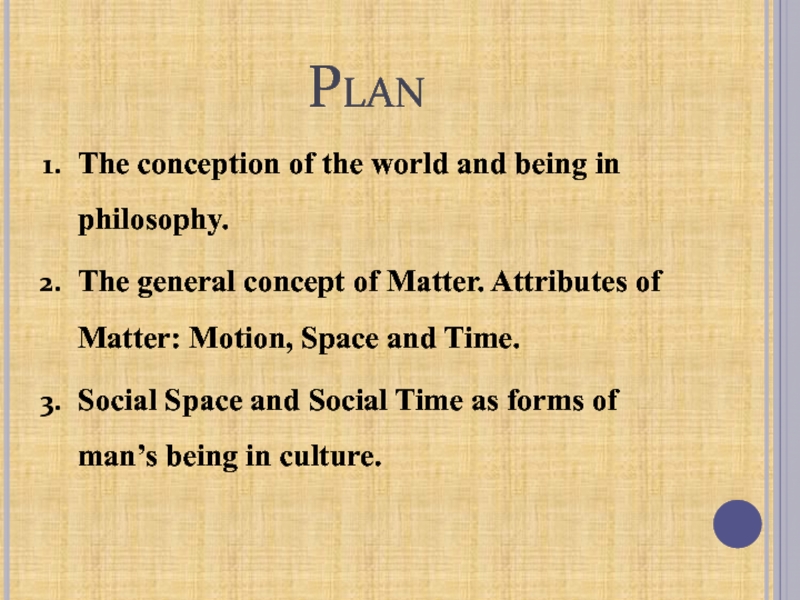
![PHILOSOPHICAL THEORY OF BEING LiteratureBasic:Alexander Spirkin. Dialectical Materialism / Alexander Spirkin : [transl. by Robert LiteratureBasic:Alexander Spirkin. Dialectical Materialism / Alexander Spirkin : [transl. by Robert Daglish]. — M. : Progress Publishers,](/img/thumbs/40385b074fe4e4d006c0021b1037955a-800x.jpg)
